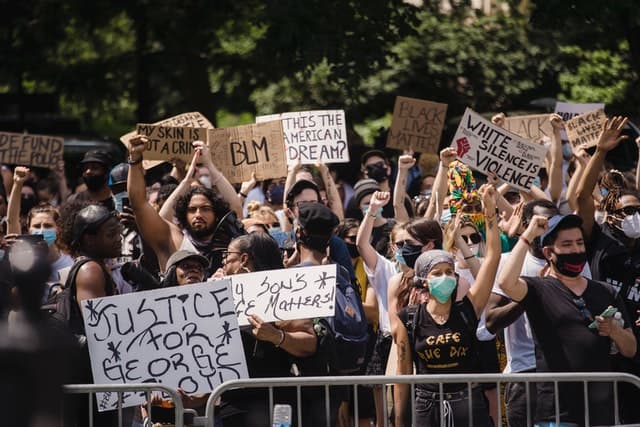The New Culture War: the Secular Right Versus the Woke Left
The left’s identity politics and politically correct stands have become self-destructive, leaving an opening the post-religious right is seizing.

This month, I’ve come across two outstanding articles by writers I had not previously known on important trends on the political right and political left.
One is “What Comes After the Religious Right?,” a guest essay in the New York Times written by Nate Hochman, an Intercollegiate Studies Institute fellow at National Review. He argues that “the conservative political project is no longer specifically Christian” and has become a battle between “the woke and the unwoke.”
The other is “Elephant in the Zoom” by Ryan Grim, the Washington bureau chief for the Intercept, describing at impressive length “the destructive capacity of the new culture inside progressive organizations.”
Credit is due to both publications. In June 2020, the New York Times editorial page editor was forced out for running an article by Senator Cotton urging that, as in 1967 and 1992, federal troops be sent to quell violent rioting. Similarly, founding editor Glenn Greenwald left the Intercept because of “political censorship” in October 2020. Evidently, the New York Times and the Intercept are now willing to tolerate unwelcome views.
In his early 20s, Mr. Hochman takes a long view of conservatism, going back to the pre-religious-right 1970s. Religious conservatives, he notes, “have sustained a long string of losses in the culture war.” School prayer is still banned; pornography is universally available; same-sex marriage is not only legal but is approved by a majority of Republican voters.
Church attendance and adherence have declined, and the devout President George W. Bush has been displaced by the dissolute President Donald Trump. Typical Republicans these days are “Middle American Radicals,” noncollege-educated whites with “a populist hostility to elite pieties” — more nationalistic and hostile to free trade and immigration than were conservatives imbued with “Christianity’s universalist ideals.”
As the New York Times’s Ross Douthat tweeted after Mr. Trump’s first 2016 primary wins, “If you dislike the religious right, wait till you meet the post-religious right.”
This nonreligious conservatism, as shown by Mr. Trump’s success with working-class and Hispanic voters, has broadened the Republican Party’s appeal. Secular conservatives, with public opinion on their side, have been passing multiple state laws banning critical race theory and transgender athletes in women’s sports.
Such conservatives, Mr. Hochman argues, are responding to progressives’ move from a “live-and-let-live philosophy” to an intolerant “demand for affirmation.” Mr. Grim seems to agree.
He describes how left-wing organizations “have been locked in knock-down, drag-out fights between competing factions,” usually “along staff-versus-management lines.” The result is “wrenching and unremitting turmoil” to the point that many progressive organizations have “effectively ceased to function.”
Even as Biden Democrats reached out for support in 2021, “the backbone of the party’s infrastructure” was “in virtual retreats, Slack wars, and healing sessions, grappling with tensions over hierarchy, patriarchy, race, gender, and power.”
“We’re dealing with a workforce,” Mr. Grim quotes veteran organizer Loretta Ross, “that’s becoming younger, more female, more people of color, more politically woke.” A workforce nurtured on campuses where, as Greg Lukianoff and Jonathan Haidt have described, a coddled generation has bullied one university administrator after another.
For many years, campuses, like Ms. Ross’s “workforces,” have been “more female.” In between the lines of accounts of campus rebellions, I get the sense these rebellions are increasingly sparked by female students demanding some kind of affirmation rather than male students demanding specific reforms.
That brings to mind psychologist Deborah Tannen’s 1990 bestseller “You Just Don’t Understand,” which described how, in response to problems, men tend to abruptly suggest specific solutions while women yearn for repetitious assurances that others understand how they feel.
Staff “expect the organization to be all things,” one executive director told Mr. Grim. “Can you get your love and healing at home, please? But I can’t say that, they would crucify me.” All of which seems to refute those consultant studies that conveniently conclude that diverse workplaces are more productive and creative than those dominated by straight, white men.
Mr. Grim argues that the election of Mr. Trump as president and the protests following George Floyd’s death were “trigger events” that seemed symptomatic of societal problems and sparked mass protests. But those are usually followed by a “turning inward” — a stage he sees the left in now.
The short-term result is that Mr. Grim’s left has gotten stuck making politically correct stands — defunding police, transgender athletics — that initially seemed as popular as same-sex marriage. But this identity politics has become self-destructive and, as predicted by many of us, unpopular in the wider society, leaving an opening Mr. Hochman’s post-religious right is seizing.
The longer view? More culture wars, probably, with some unexpected outcomes. And maybe some wistful yearning for “Christianity’s universalist ideals.”
Creators.com

